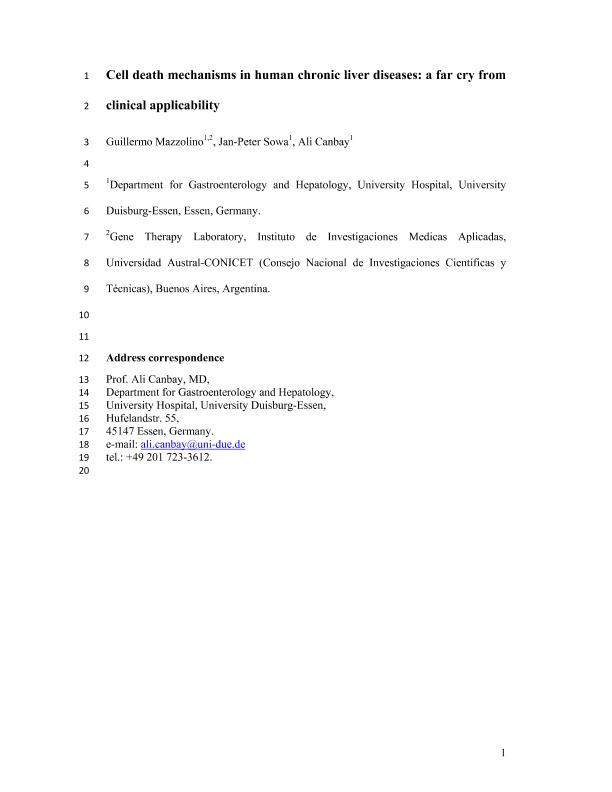Mostrar el registro sencillo del ítem
dc.contributor.author
Mazzolini Rizzo, Guillermo Daniel

dc.contributor.author
Sowa, J. P.
dc.contributor.author
Canbay, A.
dc.date.available
2018-05-11T14:50:54Z
dc.date.issued
2016-10
dc.identifier.citation
Mazzolini Rizzo, Guillermo Daniel; Sowa, J. P.; Canbay, A.; Cell death mechanisms in human chronic liver diseases: a far cry from clinical applicability; Portland Press; Clinical Science; 130; 23; 10-2016; 2121-2138
dc.identifier.issn
0143-5221
dc.identifier.uri
http://hdl.handle.net/11336/44905
dc.description.abstract
The liver is constantly exposed to a host of injurious stimuli. This results in hepatocellular death mainly by apoptosis and necrosis, but also due to autophagy, necroptosis, pyroptosis and in some cases by an intricately balanced combination thereof. Overwhelming and continuous cell death in the liver leads to inflammation, fibrosis, cirrhosis, and eventually hepatocellular carcinoma. Although data from various disease models may suggest a specific (predominant) cell death mode for different aetiologies, the clinical reality is not as clear cut. Reliable and non-invasive cell death markers are not available in general practice and assessment of cell death mode to absolute certainty from liver biopsies does not seem feasible, yet. Various aetiologies probably induce different predominant cell death modes within the liver, although the death modes involved may change during disease progression. Moreover, current methods applicable in patients are limited to surrogate markers for apoptosis (M30), and possibly for pyroptosis (IL-1 family) and necro(pto)sis (HMGB1). Although markers for some death modes are not available at all (autophagy), others may not be specific for a cell death mode or might not always definitely indicate dying cells. Physicians need to take care in asserting the presence of cell death. Still the serum-derived markers are valuable tools to assess severity of chronic liver diseases. This review gives a short overview of known hepatocellular cell death modes in various aetiologies of chronic liver disease. Also the limitations of current knowledge in human settings and utilization of surrogate markers for disease assessment are summarized.
dc.format
application/pdf
dc.language.iso
eng
dc.publisher
Portland Press

dc.rights
info:eu-repo/semantics/openAccess
dc.rights.uri
https://creativecommons.org/licenses/by-nc-sa/2.5/ar/
dc.subject
Cell Death
dc.subject
Chronic Liver Diseases
dc.subject.classification
Gastroenterología y Hepatología

dc.subject.classification
Medicina Clínica

dc.subject.classification
CIENCIAS MÉDICAS Y DE LA SALUD

dc.title
Cell death mechanisms in human chronic liver diseases: a far cry from clinical applicability
dc.type
info:eu-repo/semantics/article
dc.type
info:ar-repo/semantics/artículo
dc.type
info:eu-repo/semantics/publishedVersion
dc.date.updated
2018-03-27T15:14:52Z
dc.journal.volume
130
dc.journal.number
23
dc.journal.pagination
2121-2138
dc.journal.pais
Reino Unido

dc.journal.ciudad
Londres
dc.description.fil
Fil: Mazzolini Rizzo, Guillermo Daniel. University Duisburg-Essen; Alemania. Universidad Austral. Facultad de Ciencias Biomédicas. Instituto de Investigaciones en Medicina Traslacional. Consejo Nacional de Investigaciones Científicas y Técnicas. Oficina de Coordinación Administrativa Parque Centenario. Instituto de Investigaciones en Medicina Traslacional; Argentina
dc.description.fil
Fil: Sowa, J. P.. University Duisburg-Essen; Alemania
dc.description.fil
Fil: Canbay, A.. University Duisburg-Essen; Alemania
dc.journal.title
Clinical Science

dc.relation.alternativeid
info:eu-repo/semantics/altIdentifier/doi/http://dx.doi.org/10.1042/CS20160035
dc.relation.alternativeid
info:eu-repo/semantics/altIdentifier/url/http://www.clinsci.org/content/130/23/2121.full-text.pdf
Archivos asociados
